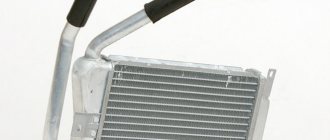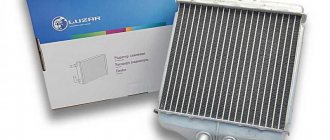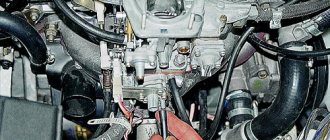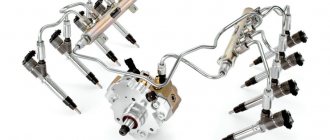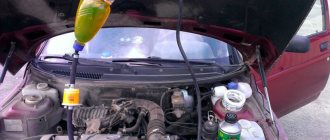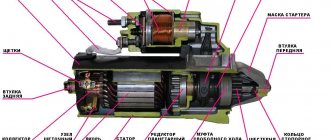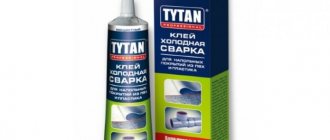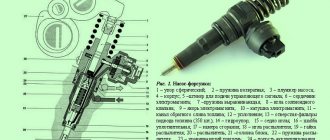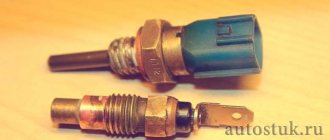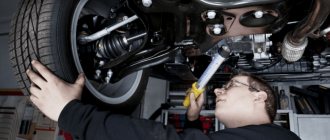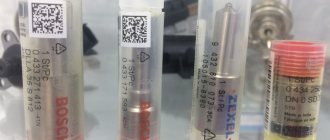For normal operation of a diesel engine, working injectors are a prerequisite. High-quality fuel injection affects the efficiency of its combustion. Periodic checks must be carried out to ensure timely diesel injector repair. You can do this yourself or contact the service.
Injector diagnostics
Before taking any action, it is necessary to conduct a thorough diagnosis. This can only be done by professional technicians working in the service center. A special test is carried out to check the mobility of the needle on the sprayer. The pressure level inside the Common Rail injector and the shape of the fuel spray during engine ignition are also checked.
Control values depend on the car brand and equipment features. The indicators can be recorded using specialized equipment that allows you to determine the amount of incoming fuel.
Adjusting the fuel injectors
Over time, the efficiency of fuel injectors decreases, so it is necessary to carry out their timely adjustment. The injectors are checked and adjusted on a specialized stand, which checks the injection start pressure, tightness and quality of fuel atomization, which cannot be done in an ordinary garage not equipped for these purposes. Lack of timely adjustment can lead to increased wear of parts, which in turn can lead to leaks and leaks.
It should be remembered that the service life of gasoline injectors is about 200 thousand km, and diesel injectors are 90 thousand km and they need to be checked and adjusted more often.
It is very difficult to adjust the fuel injectors on your own, so we recommend seeking help from specialists.
Service station “AUTO-MAXIMA” is ready to offer you its services for diagnosing and adjusting fuel injectors.
Design and principle of operation of a diesel engine injector
The injector is one of the main elements of the propulsion system. The part is responsible for the proper and timely supply of fuel to the combustion chamber. The design may vary depending on the car model. It consists of a housing, a needle for metered fuel injection, a rod, a spring, a fitting for inlet and outlet, and a filter.
In general, the device's operating cycle looks like this:
- The high pressure fuel pump takes fuel from the tank.
- The injection pump saturates the fuel with diesel fuel.
- Fuel enters the nozzle through underwater channels.
- The fuel is directed to the spray needle.
- When the maximum pressure level is reached, fuel is injected into the combustion chamber.
If one of the system elements malfunctions, problems occur in the motor system. In this case, it is necessary to carry out diagnostics for the purpose of subsequent repair of the Common Rail.
Types of nozzles, purpose
The operating principle of diesel and gasoline injectors is the same, i.e. fuel, passing under high pressure through a specially shaped nozzle, is sprayed in the form of a fuel torch, in which liquid fuel is divided into microscopic droplets and mixed with air. However, the injectors of injection gasoline engines and the injectors of diesel engines operate under different pressures; if on gasoline engines a pressure of several atmospheres is created, then the injectors in diesel engines operate under a pressure of hundreds and thousands of atmospheres.
Today, depending on the injection method, the following types of injectors are used:
- Mechanical;
- Electromagnetic (electromechanical);
- Electrohydraulic;
- Piezoelectric.
Each type of injector has its own repair nuances, scope of application and features.
Mechanical injectors
Mechanical injectors are a simple classic solution that still remains relevant today. A mechanical nozzle consists of a body with a needle located inside, which closes the nozzle under the action of a spring. When the pressure increases, fuel from the injection pump enters the annular chamber between the needle and the housing, due to which the needle rises, at this moment the nozzle opens, then the fuel is sprayed into the combustion chamber. When the pressure decreases the nozzle closes again.
In more understandable terms, a mechanical injector is a device of the fuel system and is responsible for supplying fuel to the engine cylinders. In order for the engine to work properly, it is necessary that the fuel-air mixture constantly burns; for this, it is necessary to strictly observe the correct proportions of the ratio of air and gasoline, which is what the mechanical injector actually provides (non-stop spraying of fuel can dismount with air in the optimal ratio). The spraying process in such a system is carried out thanks to nozzles.
Mechanical injectors have been replaced by electronic devices quite a long time ago. The main difference between them is the force that causes the injectors to open and spray fuel. In the electronic version, the injectors open due to an electronic impulse, and in the mechanical version, due to the pressure that is specially created in the system. In other words, the mechanical injector dispenser is responsible for controlling the mechanical injectors. The disadvantage of a mechanical device is that engine speed directly depends on what pressure is maintained in the fuel system.
A mechanical injector is a fairly simple and reliable mechanism, however, it cannot provide the necessary characteristics that are declared for the operation of modern diesel engines, which use completely different types of injectors.
As a rule, this type of injector is not particularly expensive, so if it breaks, it is most often replaced with a new one. The approximate average cost of a BOSCH injector ranges from 1,000 to 3,000 rubles.
Electromagnetic injectors
The electromagnetic injector is found under the hood of cars with a gasoline engine. The principle of their operation is quite simple. The design is based on an electromagnetic valve and a nozzle, inside of which there is a movable needle. Unlike a mechanical injector, in an electromagnetic injector the needle rises due to a built-in electromagnet based on a signal from the controller. The electromagnet is located at the top of the injector, and the needle is connected to the armature of the electromagnet, so when voltage is applied, the needle goes up, thereby opening the nozzle and gasoline is injected under pressure into the intake manifold or directly into the cylinder. When the control signal disappears, all elements return to their original position under the action of a spring. This type of injector is not used for diesel engines, because they are not designed to withstand the high pressure that is created in them.
Repair of electromagnetic injectors
The technical capabilities of our car service allow us to restore the functionality of all electromagnetic injectors from Bosch, Denso, Delphi. We have spare parts for repairs in stock, so we can quickly repair a faulty injector.
Electrohydraulic injectors
The electrohydraulic nozzle combines the advantages of a mechanical nozzle and an electromagnetic one.
Electrohydraulic injectors, unlike electromagnetic injectors, have a more complex design. The main elements of such an injector are a solenoid valve, a control chamber, as well as an inlet and drain throttle.
Electro-hydraulic injectors are used to regulate fuel supply in diesel engines.
In an electro-hydraulic injector, fuel presses on the needle from two sides - bottom and top - where the fuel chambers are located. The upper control chamber is connected to the drain line through an electromagnetic valve, and fuel from the inlet line enters this chamber through a narrowed channel.
The principle of operation of this device is as follows: the fuel is under pressure both in the closed state and during injection. When there is no injection, the needle is pressed tightly against the nozzle by the pressure of the fuel in the control chamber.
At the moment of injection, a signal is sent to the solenoid valve, at this moment the drain throttle opens, fuel from the control chamber enters the drain line and the pressure in the chamber drops sharply, at this moment the needle, on which the fuel is currently acting only from below, opens, injection occurs the required portion of diesel fuel. When the injector opens, the control chamber remains connected to the intake manifold, but the intake throttle prevents fuel from quickly filling this chamber.
Let us repeat that this type of injectors is used in diesel power plants, and they have also found their application in the Common Rail system, which is quite popular today. Such reliable and simple devices are capable of ensuring high-quality and long-term operation of a diesel engine.
Piezoelectric injectors
The piezoelectric injector is a reliable device, which, unlike its counterparts, is the highest speed and most advanced.
This type of injector is used on diesel engines with a Common Rail injection system. The main feature of such an injector is the piezoelectric element, thanks to which the developers were able to create a fast-action nozzle design. The piezoelectric element can instantly increase in size under the influence of electrical voltage, while affecting other parts of the injector. Piezoelements of this kind are currently also used as control elements in pump injectors, which combine a high-pressure plunger pump and an injector. This hybrid can only be found in diesel engines.
Unlike hydraulic injectors, piezoelectric injectors operate 4 times faster, which is its main competitive advantage; this makes it possible to perform multiple fuel injections in one engine operating cycle. Multiple injections per stroke can significantly improve the performance of the engine itself.
The principle of operation of this nozzle is similar to the principle of operation of an electrohydraulic type nozzle, the only difference is that in it the valve that opens the way for fuel into the drain line from the upper chamber is activated under the influence of a piezoelectric crystal.
As is known, a number of crystals have a piezoelectric effect, i.e. under the influence of external force they are capable of deforming with the formation of an electric charge. They are also subject to the opposite effect under the influence of electricity; crystals are capable of deformation, changing their size.
Cleaning piezoelectric injectors
Piezoelectric injectors from Bosch, Denso and Delphi have one significant drawback: they cannot be repaired, with the exception of some Continental injectors; there are spare parts for them.
The piezoelectric injector can be washed by removing its tip. In our car service center, the nozzle tip is washed using an ultrasonic device. For a thorough inspection and diagnosis, the piezoelectric injector is removed and its operation is checked on a stand.
FSI injectors
For injection engines with direct injection, there is a separate type of injectors, which have their own name, GDI or FSI, the main difference of which is the high response speed and the increased voltage at which they operate.
FSI injector design
This type of injector is used for engines with direct fuel injection running on ultra-lean mixtures. The main function of GDI injectors is the precise timing of the lowering and raising of the working needle. Unlike conventional injection engines, where the injector opening time is 2-6 ms, the injector opening time in ultra-lean-burn engines is about 0.5 ms. Therefore, the standard voltage of 12 V supplied to the injector can no longer provide the required response speed. To solve this problem, this type of injector works using Peak-n-Hold technology. In other words, a high voltage is applied to the coil, the operating current in the coil increases quite quickly, while its winding does not burn out due to the available back EMF, then quickly drops, at which point the Hold phase begins. The fuel injection time is from the beginning of the pulse to the second inductive surge. This method is actively used by automakers General Motors and Mitsubishi, while manufacturers Volkswagen and Mercedes use developments from Bosch, the method of which involves a system that does not reduce voltage, but uses pulse-width modulation (PWM). This algorithm is implemented using a special block – Driver Injector, located near the injectors. For example, Merscedes and Toyota companies place the block in a horizontal position in the area of the shock absorber cup, which is currently a more optimal solution.
PWM on FSI
FSI power units with a power of more than 90 hp are equipped with an improved fuel system, which has a number of distinctive features:
- Parts of the injector ramp and high-pressure pump have a special anti-corrosion coating that protects them from exposure to fuel containing up to 10% ethanol
- Its modified high pressure pump control
- There is no fuel drain pipe to the tank
- The fuel discharged through the safety valve installed on the injector rail is discharged through a short pipeline into the low-pressure circuit, before the high-pressure pump.
To summarize, you should pay attention regarding the operation of GDI engines, they are quite sensitive to the quality of the fuel used and require timely replacement of the fuel filter. It is also necessary to promptly change the oil and clean the fuel system.
Our service center team is ready to provide professional assistance in servicing GDI engines.
Operating principle of a diesel engine injector
A mechanical nozzle works as follows. On the side there is a channel through which diesel fuel enters. Inside the chamber there is a spray needle and a spring, which is activated when a certain pressure level is reached. After this, an outlet channel opens, through which fuel is injected into the combustion chamber.
Depending on the model, there are the following nozzles:
- With pump. Installed in cases where there is no fuel injection pump. The fuel goes directly to the injector. The part has its own fuel injection pump.
- Piezoelectric. The spring is activated under the influence of a piezoelectric element. This approach provides more economical fuel consumption.
- Electrohydraulic. The system operates under the influence of the control unit.
Basic faults
Modern manufacturers produce injectors with a tolerance of 1 micron, that is, the product is capable of performing about a billion operating cycles of fuel dosing and supply. However, they usually fail before their deadline, since their productivity can be sharply reduced due to contamination. The quality of the fuel directly affects the service life of the part.
The main cause of pollution is the inevitable presence of heavy particles in gasoline or diesel fuel.
In this case, the accumulation of dirt mainly occurs immediately after the trip, that is, as soon as the driver turns off the engine. At this moment, the nozzle is very hot from the engine, and the coolant no longer flows because the engine is not running. Light particles of fuel that remain in the body evaporate, and heavy ones settle.
Signs of trouble
The car owner can independently diagnose injector malfunctions. To do this, you need to carefully monitor any changes in engine operation. So, the following signs indicate a problem on any fuel-injected car:
- difficulty starting the engine;
- interruptions at idle;
- loss of power;
- increased fuel consumption;
- popping noises in the exhaust system and muffler;
- failures in engine operation when pressing the gas sharply.
In this case, problems are easiest to notice in the winter: if the injectors are heavily dirty or the rubber seals are worn out, the engine will be very difficult to start “in cold weather”.
Test stand and equipment
Most often, having noticed the above signs, the car owner turns to a service station to check the functionality of the injectors. There are special stands that allow you to quickly find a malfunction. The latest generation equipment is equipped with sensors and modulators that provide high diagnostic accuracy.
The equipment allows you to quickly identify any problems in the operation of injectors
The test stand allows you to test from one to six pieces at a time, while work is carried out in several directions at once:
- fuel supply speed;
- coil resistance measurement;
- valve response time;
- clarification of fuel dose volumes for injection;
- degree of needle contamination.
Inspection usually requires removing them from the engine. The owner does not always have time to complete this procedure, so service centers also offer alternative verification methods. For example, today service stations use instruments for testing directly on the engine. The compact device quickly and accurately detects the efficiency of the injector and signals its malfunction.
Allows you to diagnose problems in each injector in turn
Why might the injector knock?
Sometimes after replacing or repairing an injector, the car owner may hear a knocking sound. Why does it knock if a new product has just been installed? It's all about tightening the connections. It is necessary to securely fix the part with a nut, but do not pinch it. The rubber seal quickly fails, so the body begins to knock loudly when driving.
What to do if diesel fuel is leaking
In some cases, during prolonged use, you may notice that one or more injectors begin to leak. That is, small accumulations of fuel form at the exit from the cylinder head. On car enthusiast forums, the question is often asked what to do in such cases, and car owners usually do the following:
wipe dry the injector and the nut securing the fuel pipe, and the place where the injector is screwed into the head of the internal combustion engine. With ordinary chalk, cover (rub) the indicated places and parts. (If the chalk has darkened, wipe again and cover with chalk again until it remains white) Turn the engine over with the starter 2–5 seconds. If it starts right away, turn it off. Look where it’s leaking. If it’s from under the nut of the fuel pipe, only replacing the pipe or restoring it, an inspection will show. If the injector body is sweating or leaking, then dismantle it and go to the fuel manifold (on the eve of winter, it won’t hurt if you remove all injectors and for diagnostics) if it sweats or leaks between the injector and the head, just remove the injector and change the copper o-ring
Yuri Pobeda
https://www.offroadmaster.com/topic/39398-%D1%82%D0%B5%D1%87%D0%B5%D1%82-%D1%84%D0%BE%D1%80%D1% 81%D1%83%D0%BD%D0%BA%D0%B0-%D0%BD%D0%B0-%D0%B4%D0%B8%D0%B7%D0%B5%D0%BB%D0% B5-%D1%87%D1%82%D0%BE-%D0%BF%D1%80%D0%B8%D0%B4%D1%83%D0%BC%D0%B0%D1%82%D1% 8C/
No fuel supply
If there is no gasoline in the engine, it is not only the injectors that are to blame. It is necessary to check the capacity of the fuel lines. If the hoses are not clogged or leaking, then the problem is with the fuel pump.
Increased fuel consumption
The most common malfunction to which all types of these parts are susceptible is contamination of the exhaust channel, which increases fuel consumption. It is necessary to rinse it (the use of special additives in the gas tank is allowed). If this measure does not help (they are very clogged), you will have to remove them from the engine and clean each one separately. To do this, use an aerosol can for cleaning engines and a syringe through which the cleaning liquid penetrates inside.
Reasons for repairing diesel engine injectors
The need to repair diesel engine injectors can be explained by the constant load. It is necessary to highlight the following factors that affect equipment wear:
- low fuel quality - the presence of impurities that lead to injector combustion;
- the presence of dyes in the fuel - for this reason, the internal channels of the device become clogged, which leads to a decrease in performance;
- the presence of carbon impurities in the fuel liquid that do not evaporate during fuel combustion;
- the presence of small parts and dust that are deposited on the walls of the nozzle - this accelerates equipment wear.
Signs of a faulty diesel engine injector
The listed factors can lead to breakdown. You should pay attention to the following signs indicating a device malfunction:
- increased fuel consumption;
- power reduction;
- long acceleration;
- vibrations in the propulsion system;
- uncharacteristic sounds when the engine is running;
- increased amount of oil in the pan;
- The engine runs rough at idle.
These symptoms indicate that there is a problem. It is urgent to diagnose the diesel engine to check the source of the malfunction.
Checking the injector without removing the engine
To check the operation of parts, you can use several methods.
- Analyze the noise emitted by the power plant during operation. This is the simplest test option and does not require dismantling. A characteristic high-frequency sound produced by one of the injectors will indicate its malfunction and the need for cleaning or replacement.
- Disconnecting connectors one by one. Usually, when the injection elements are dirty or faulty, the engine runs with vibrations. It will be possible to detect the “weak link” if you disconnect the connectors one by one. The speed of the power plant has dropped to zero, which means that this element is working normally. And so continue for each one. If the speed does not drop, this is a faulty part.
- Battery A battery test is carried out in order to find out how fuel is supplied and in what quantity. Two wires are connected to the external power battery (minus and plus, respectively). The other ends of the cable are attached to the injectors. Before doing this, the power supply must be disconnected. Then start the engine and see from which part and how much fuel leaks. A strong leak will indicate a problem in the vehicle's electrical circuit.
- Multimeter. The device makes it possible to measure the resistance on the injection elements. If the indicator on elements with high impedance does not correspond to the value of 11-17 Ohms, then the parts are faulty. For injectors with low resistance, the standard is 2-5 ohms. You can also measure the voltage supplied to the injection elements. If the current flows normally, then everything is fine.
- Known good part. If you suspect some kind of injector, then simply install a working one in its place. In this way, it will be possible to check whether the nature of the operation of the power unit is changing.
Reasons for replacing injectors
Any nozzle becomes clogged over time. The reason is the low-quality fuel that we fill at gas stations. Modern fuel contains a large amount of resins that settle on the elements and reduce their throughput. Also, the elements may become dirty due to the filter not being replaced in a timely manner.
The blockage can be cleared, but in some cases it is more rational to replace it. Very dirty, coked elements definitely need to be replaced, since cleaning will no longer help.
Diesel engine injector malfunctions
When an injector breaks down, the following malfunctions occur:
- combustion products remain on the atomizer;
- the piston surface wears out;
- the seal is deformed;
- the appearance of nozzle deformations;
- burnout of the electromagnetic coil;
- the appearance of rust in the filter;
- the tip of the sprayer melts;
- mechanical damage to injector components.
These breakdowns indicate the need to replace equipment. You should contact specialists in a timely manner.
Nozzle sprayer repair
Since the purchase and installation of a new nozzle is associated with quite serious financial costs, often only the atomizer is replaced. It consists of a body and a needle located inside. During operation, the seating surfaces become deformed and the sprayer begins to work incorrectly.
Sprayer repair is possible in the following cases:
- Sticking of the needle in the body due to contamination, deformation, scuffing or chipping of the working surfaces.
- Spray nozzle is dirty.
Procedure for repairing a sprayer
There are several ways to repair a sprayer. One of them is ultrasonic cleaning, which is used to remove carbon deposits from internal surfaces. However, if the sprayer is highly coked, complete removal of carbon deposits using this method is impossible. Moreover, ultrasound cannot restore mechanically worn surfaces.
One of the options for repairing a sprayer is ultrasonic cleaning.
Another option for repairing nozzles is grinding in using polishing pastes of varying degrees of grit. The disadvantage of this method is the possible violation of the geometry of the relative position of the parts. As a result, fuel may leak into the injector from the atomizer. Lapping will not help in case of severe mechanical deformation of the surfaces.
The injector elements are arranged in a strictly defined sequence
Grinding is carried out as follows.
- The nozzle is clamped in a vice. The nut securing the sprayer is unscrewed.
- The needle is washed in a container with fuel, wiped with a clean rag and blown with compressed air.
- To grind the needles, use a paste containing an abrasive and a cast iron lap for final processing. The needle is passed over the lap to remove marks. At the same time, the appearance of new damage should be avoided.
- Nickel plating restores the working volume of the needle.
- The spray body is machined. It should take on a smooth and shiny appearance.
- The needle is inserted into the body. The gap between the needle and the body should not exceed 1–2 microns. Otherwise, nickel plating should be repeated.
Thus, repairing the sprayer consists of cleaning it from carbon deposits, grinding it and increasing the volume. This process is quite labor intensive. If almost every car owner can replace an injector nozzle, then for independent repairs you will need special equipment.
Video: repairing a diesel injector nozzle
Grinding in the sprayer
To avoid mistakes, the process of grinding in nozzles should be considered in more detail. For grinding you will need:
- paste GOI;
- thick automobile oil;
- drill.
GOI paste is crushed into powder and diluted with oil in a ratio of 1 to 2. Then the composition is applied to the sprayer body, the needle is clamped into a drill, and grinding into the body is carried out at the lowest speed. In this case, it is necessary to tap the needle on the body for a minute. Then the parts are washed in clean fuel and purged with a compressor. After this, grinding is carried out only with oil.
All elements, including the nozzle itself, are washed in kerosene, purged and assembled.
The seat for the needle in the sprayer body is restored by grinding in using special pastes
How to extend the life of your sprayer
To increase the service life of the sprayer, it is recommended to adhere to a number of simple but important rules:
- refuel only with high-quality fuel at proven gas stations;
- change the fuel filter promptly;
- use fuel additives that clean the fuel system from water and impurities;
- If problems arise in engine operation, immediately carry out diagnostics at a service station.
These simple recommendations will help you avoid serious expenses when unscheduled replacement of injectors.
The algorithm for replacing injectors on a diesel engine is quite simple. Even an inexperienced car enthusiast can do this. Sprayer repair is more complex and time-consuming. However, if you have the desire and the necessary tools, you can also do it yourself. Refuel with high-quality fuel, change fuel filters in a timely manner, and problems with injectors will occur much less frequently. Good luck on the roads!
Technology for repairing diesel engine injectors
The repair procedure is as follows:
- General check of all vehicle systems.
- If defects in the fuel system are detected, the check is carried out using a diagnostic stand.
- If the nozzle is slightly dirty, clean it using special substances.
- In case of serious malfunctions, the equipment is dismantled.
- The injectors are completely disassembled to check all elements.
- A special ultrasonic bath is prepared for cleaning.
- Before assembly, check for external damage.
- After all work is completed, the parts are assembled and installed back directly on the engine.
Causes of malfunction of injection nozzles
Nozzle device
Modern fuel injectors in gasoline engines come in two types: electromagnetic and mechanical. The first is a solenoid valve that is controlled by the vehicle's ECU system. When the appropriate signals are given, the valve opens to a certain angle, regulating the amount of fuel supplied to the cylinder. The second only supplies fuel to the channel. Its design includes a needle with a step. When there is enough pressure, the fuel overcomes the resistance of the spring and the needle rises. Accordingly, the nozzle opens and fuel is supplied to the chamber. Currently, electromagnetic injectors have gained wide popularity as they are more technologically advanced. Therefore, we will further consider checking and cleaning using their example.
There can be only a few malfunctions of the electromagnetic injector:
- lack of signal from the ECU;
- malfunction or complete failure of the winding;
- nozzle outlet is clogged.
As practice shows, it is the latter option that is the most common cause of complete or partial failure of the nozzle.
What is the Common Rail system?
This is a system for supplying diesel fuel. A battery is also used to improve the performance of the propulsion system.
What do you need to know about common rail injectors?
Common Rail allows you to regulate pressure and determine the timing of fuel injection, which is a definite advantage. Please note the following:
- simple design makes it easy to repair the part;
- stable pressure is always maintained;
- precise fuel dosage.
There are several different injectors for diesel engines . Below are the most common ones.
Bosch electromagnetic injectors
Experts note the ease of repairing Bosch injectors. Most often the atomizer and multiplier break. During operation, this valve is often affected by other elements. The sprayer is subject to mechanical wear.
Delphi electromagnetic injectors
The nozzle and valve often break. At the same time, repairing a Delphi injector is simple when using suitable equipment. It is enough to change the valve and clean the atomizer in an ultrasonic bath.
Denso electromagnetic injectors
It wears out after 150 thousand kilometers. The device is inexpensive. If the equipment fails, it is easier to buy a new one.
Piezoelectric injectors Continental Siemens
Repairing a Siemens injector can be expensive. The reason is the innovative technology of metered fuel injection. Repair parts will cost the same as a new device.
Piezoelectric injectors from Bosch
Most often, the valve mechanism or accumulator fails. Therefore, repairing Bosch diesel injectors is expensive.
Piezoelectric injectors Denso
It is better to order a new device than to repair an old one. The cost is the same. At the same time, the new part will last longer.
Disassembling the nozzle
In most cases, injector repair can be done by replacing the filter, which is installed at the top of the injector where it connects to the fuel hose. To remove the filter, the main tool is to use a self-tapping screw, which is screwed 2-3 turns into the mesh filter and removed from the nozzle body.
Then, in place of the removed filter, a new mesh filter and o-ring are installed. In this way, it will be possible to ensure stable filling of the injector with clean fuel, which will have a positive effect on the operation of the injection engine.
Adjusting nozzles at home is a completely doable task if you have minimal experience in handling tools. For home craftsmen who have at least once disassembled the carburetor and eliminated engine overflow, it will not be difficult to clean the injectors.
Restored injectors can last for a long time, and if all cleaning and repair actions were carried out according to the rules, then the vehicle will be operated without serious deviations in the fuel supply system.
If you have any questions, leave them in the comments below the article. We or our visitors will be happy to answer them
How to make a replacement yourself
Most often (due to contact with the combustion chamber) it is the nozzles that fail. And this adversely affects the operation of the motor. At the same time, the easiest way is to change this product, rather than spend money on buying a new one.
When replacement is required
Determining that the sprayer is on the verge of its performance is quite simple. To do this, you just need to carefully monitor the behavior of your car:
- fuel is supplied in a larger volume than necessary (injectors may leak);
- fuel is supplied in a minimum volume (the engine runs with dips, it’s difficult, idling is extremely unstable);
- the fuel supply continues even when the part has completed its work cycle (drips form);
- exhaust gases acquire a black color and increased density (due to incorrect operation of the atomizer, not all the fuel burns in the chamber);
- for the same reason, engine power decreases.
Preparing the tools
In order to remove the old one and install the new one, you will need to prepare:
- a set of open-end wrenches (different wrenches will be used for different injectors);
- extension.
You also immediately need to prepare a small container and fill it with the fuel used to wash the parts.
Sprayer replacement work
The car owner must be aware that simply replacing the nozzle (unscrew the nut, replace the nozzle on the injector and tighten the nut) is not a solution to the problem. It is quite possible that after such a makeshift replacement the part will work even worse.
So, the guide to replacing the nozzle on a diesel injector includes several steps:
- The nozzle body must be placed in a vice.
- You can easily unscrew the nut from a fixed nozzle using a regular spanner wrench with an extension. The extension is needed so as not to break the nut while unscrewing.
- After removal, the nut must be washed to remove carbon deposits and dirt.
- Rinse the sprayer body itself in a clean bath of fuel and wipe dry with a clean, lint-free cloth.
- The faulty sprayer can be thrown away.
- Be sure to rinse the new atomizer in fuel, thereby washing away the slightest specks of dust that might stick to it.
- The sprayer itself is inserted into the body and tightened with a washed nut. You need to tighten it with a wrench and an extension, without fanaticism.
- After this, be sure to check the part on the stand.
Video: main nuances during repairs
If the sprayer was replaced correctly, the stand will show the optimal throughput. The main thing is to maintain cleanliness when replacing a new product. Since if even one speck of dust or sand gets into the device, the work can be considered in vain.
Prices for diagnostics of gasoline injectors
Scroll to block When there is a need to check the condition of the injector, the price factor for this service plays an important role.
We are often approached by clients who are quoted prices in official services that are an order of magnitude higher than those we offer. Our prices for injector diagnostics are among the lowest in Moscow. Prices for diagnostics of gasoline injectors
| Service | Price |
| Checking the piezo injector (BMW, Mersedes) on the Carbon Zapp stand, taking into account previously carried out cleaning in an ultrasonic bath | 600 rubles for 1 piece. |
| Testing of injectors on the LANTECH LUC-304 stand for injectors (Kia, Ford, Toyota, etc.) | 250 rubles for 1 piece. |
| Resistance check | Included in testing cost |
| Pressure testing, checking for fuel leaks | Included in testing cost |
How to disassemble a diesel injector for repair
So, after diagnostics on the test stand, the defective injectors should be separated, after which you can begin to repair them. In order to unscrew the element, it is not recommended to use open-end wrenches. A socket wrench is well suited for this task, as it ensures a tight grip on all edges of the nut.
The fact is that with an open-end wrench you can lick the edges on the nut; also, on some injectors, these nuts are initially fragile, that is, they can simply crack if there is uneven pressure on the edge. The problem is complicated by the fact that it can be very difficult to find nuts separately on sale.
For proper disassembly, the nozzle must be inserted into a spanner wrench, then the wrench should be clamped in a vice. Now you can unscrew the nut using the socket head. After the nut has moved a little, further unscrewing should be done by hand.
The nut can be unscrewed immediately, together with the sprayer stuck to it. If this happens, then the sprayer should be soaked in a solution for loosening soured bolts and nuts (for example, WD-40). Then it is carefully tapped out of the nut.
- To remove the sprayer, the nut must be placed on an aluminum plate in which a through hole is made. The specified hole should have a diameter that is slightly larger than the diameter of the sprayer. The plate itself is placed on the “lips” of an open vice.
- Now you need to place a rod made of copper or aluminum on the end of the nozzle, and then knock out the nozzle by lightly tapping the extension. After removing the sprayer, all elements will need to be thoroughly cleaned of carbon and deposits. This can be done using a brush with fine steel bristles.
- It is also necessary to use a carbicleaner for cleaning. If there is no such cleaner, then you can wash the parts from carbon deposits in clean diesel fuel or acetone. The final stage of washing is to rinse the nut, injector body and nozzle in clean diesel fuel.
- It is recommended to use compressed air from a compressor for drying. This approach allows you to remove small debris from the joints of the parts being joined, and also eliminates the ingress of lint particles when wiping with a rag.
- Next, you can proceed to installing a new atomizer and assembling the nozzle. First, all elements are tightened by hand, after which tightening is done using a spanner. Note that at the initial stage you should not tighten the nut too much, since it is possible that you will need to disassemble the device again.
- Now the assembled nozzle with a new atomizer will need to be re-checked on the bench. If the element begins to work properly (opens in a timely manner, sprays fuel efficiently, closes hermetically, dumps fuel normally into the return line, etc.), then it will be possible to finally tighten the nut, put the injector aside and then install the part on the engine.
During the final assembly of the injector, it is important to take into account that the union nut of the nozzle is tightened with a certain force using a torque wrench (the tightening torque is indicated in the operating and repair manual for the specific internal combustion engine). Also, before starting tightening, you need to close the holes of the washed and tested nozzle with special caps.
As a rule, immediately after replacing one nozzle, the element rarely begins to work properly, since the nozzle usually operates at low or high pressure, the nozzle overflows fuel, etc. This indicates that additional adjustment is needed.
- To ensure that the operation occurs at the required pressure, you need to select the correct adjusting washer. Adjustment is made by changing the thickness of the washer. If the response pressure is lower, then it is necessary to install thicker washers, but if the injection pressure is higher, then a thinner washer is installed.
- For accurate selection, you must have several adjusting washers in advance, as well as a micrometer to measure the thickness of the washers. Let us add that to increase the response pressure of a diesel injector by 10 kg. per centimeter, the adjusting washer should be 0.1 mm thicker. Accordingly, reducing the pressure is possible by installing washers of thinner thickness.
- As for the diameter, this indicator of the installed shims should be the same as those that were originally on the injectors. Washers must be made of durable steel, since the material determines the durability of their operation.
Let us add that after disassembling the nozzle, you may find that the shims additionally have holes. If these are the washers, then you cannot replace them with washers without holes. If washers without holes are installed as standard, then any type of washers can be installed for adjustment. The main thing is that the diameter matches.
It is also necessary to take into account that during adjustment it is advisable to adjust the injection pressure a little more (10-15 kg per centimeter) from the indicator stated by the injector and engine manufacturer in the operating manual. The fact is that after installation on the engine, the parts are seated and run-in (the needle cone “rubs in” to the seat cone of the replaced nozzle, the adjusting washer sag a little, etc.).
Note that the highest quality adjustment using shims can be considered an indicator when the actual pressure does not differ from that recommended by the manufacturer by more than 5 or a maximum of 10 kg/cm.
Let us add that the adjustment should also take into account the fact that there may be wear on the plungers in the high-pressure fuel pump itself. This means that if the pump produces reduced pressure, then it is more correct to slightly reduce the injection pressure (by 5-10 kg per centimeter).
Please note that this procedure may not be effective in all cases. For example, for a rotary fuel injection pump, it is necessary to set the exact injection pressure for each injector.
Another feature that after installing a new nozzle, the injector pours fuel may be:
- hardening of the factory preservative lubricant in the sprayer;
- the spring is worn out or there are problems with the pressure pin;
The first case is extremely rare, so let's move on to the second. After disassembling the nozzle, you should inspect the indicated elements for wear. Usually defects are clearly visible upon visual inspection. If the problem is with the spring, then the element can be deployed, but this solution is temporary. This means that it is better to immediately replace the pressure spring and other parts with new analogues.
After the injectors are assembled and properly adjusted, they can be put back on the engine. Before installation, be aware of the injector O-rings. First of all, they must be replaced with new ones after each tightening of the injectors with the recommended torque.
In other words, if the injectors have been tightened but then come off again for some reason, reusing the O-rings is strongly discouraged. The reason is simple - after tightening, the rings shrink, they lose their shape, etc.
It is also useful to know that the rings not only ensure the tightness of the connection, but also prevent the injector from overheating. The seals act as a kind of barrier, preventing excess heat from being transferred from the cylinder head to the injectors. It turns out that the degree and speed of coking of the injectors under heating conditions will depend on the quality of the rings.
